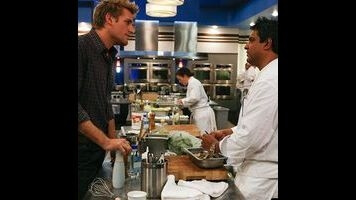Top Chef Masters: "Champions Round Begins"

First off, special thanks to Genevieve and Donna for capably—a little too capably, frankly—subbing in for me while I was away for the last two weeks. In all honesty, I was happy to leave them the final preliminary rounds, because the stop-start of having new contestants shuffled on and off the show each week was starting to be a grind. (And as an aside: While I appreciate the sportsmanship of chefs providing an excellent mystery box of ingredients for their colleagues last week, I wish they’d have at least made it challenging. That doesn’t mean sabotage, just mixing it up a bit.)
So now we head into the Champions Round and I think Top Chef Masters has found its pulse again. We’re presumably seeing the cream of the crop now—or at least the folks lucky enough to escape the first round—and it’s exciting to see the show turn into an abbreviated, four-episode version of the regular Top Chef. I suspect we’ll get a better sense of who the chefs are over this period, and perhaps some rivalries will develop between them. The sense I get from most of them is that they’re a competitive lot—you have to be to run a top-flight restaurant—and I hope a good group dynamic begins to develop.
Kudos right off the bat: It was a brilliant move on the producers’ part to kick off the Champions Round with the “mise en place” relay race, which has always been a shot of adrenaline on Top Chef. (And a chance to witness both Hung’s astonishing knife skills and Casey’s excruciating meticulousness in chopping an onion.) So what better way to get those competitive juices flowing? (Sorry for the “competitive juices” cliché, but I’m under serious time constraints tonight. Clearly, I have failed in the Quickfire metaphor challenge.) Working in teams—Rick Bayless, Hubert Keller, and Anita Lo on one; Michael Chiarello, Suzanne Tracht, and Art Smith on the other—the chefs were tasked to do the following: Shuck 15 oysters, dice five onions, butcher 4 chickens, and separates five eggs and beat them until they can stick to the bowl when suspended upside down.
Sometimes the Quickfire relays lose their suspense quickly—see the aforementioned Hung/Casey year—but this one was a nailbiter, with Suzanne taking an early (but small) lead from Hubert on the oysters, and a tight back-and-forth until the very last round, when Art and Rick squared off in the egg beating. That was when Rick, who’s fast proving himself more than a one-trick fancy-pants-Mexican pony, pulled a Hung and whipped through the eggs with blazing speed. (“Mr. Kitchen Aid,” sighed a defeated Art.) I appreciated the background on Rick, too: That he was committed, as a teacher of pastry students, to demonstrate how it’s done without using any appliances. The winning team walked away with five stars, and the losers four, though those totals didn’t factor into the elimination results at all. (In general, the star system doesn’t really work that well in a challenge like this one anyway, so I was relieved that the Quickfire served more as a primer for the Champions Round than anything more decisive.)

 Keep scrolling for more great stories from The A.V. Club.
Keep scrolling for more great stories from The A.V. Club.